Howie
Wooden Canoe Maniac
Just finished this 1944 16ft Shell Lake Guide, serial #100. It has dual carry thwarts, external stems, and seats suspended from the canoe's sides a-la Rushton. Plus there's a brass Shell Lake badge tacked to the front deck and the model # and serial # stamped onto an oval brass plate tacked to the front stem. There's also a strip of leather under each end of the front thwart meant to hold paddles.
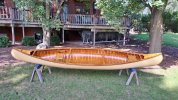

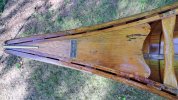
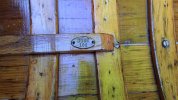
A few thoughts for those who intend to restore one of these in the future: Although the canoe does have nice features and nice lines, and it did clean up nice, Shell Lake had some serious manufacturing goofs you ought to be aware of.
First, it's nice that the canoe has a carry thwart located at each end. Unfortunately SL either made the carry thwart too long or located it too close to the decks. This caused excessive pressure on the first few screws attaching the inner rails to the deck - enough so that one of the inner rails at both ends cracked right by the 1st screw and caused the rail to pull away from the deck by 3/8". Plus one of the decks was split in half. SL had to have known about this problem because they addressed the problem of the decks splitting by squeezing the inner rails together several inches past the front of the deck using two nuts and a threaded silicon-bronze rod. This rod fit into a channel milled into the underside of the decks. What a dumb solution - clearly it didn't fix the decks from splitting and did nothing to keep the rails from cracking and/or pulling away from the decks. What I did was relocate each carry thwart 3/4" further away from the end of the deck - the screws had no trouble snugging the rails and decks together. I also glued/epoxied strips of wood to the underside of the decks to guarantee they won't split apart in the future.
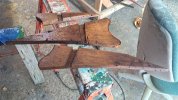

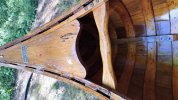
The next treat was removing the external rails. The rails were held in place in the deck area with honking big copper(?) nails where screws usually are. And while #8 silicon-bronze screws were used to attach the external rails between the decks, the screw heads were buried about 3/16" deep into the wood and covered with caulk. Happily #8 screws worked fine in the holes left by the nails. And I used cup washers on all the screws to get the screw heads to lie flush with the outer rails.
The keel was held in place using screws and finish washers, so they were easily removed. But the external stems were held in place with a #8 silicon-bronze screw at both ends and nails in between. I was very lucky to be able to remove both external stems in one piece. And on top of that (literally) 1/2" wide aluminum stem bands were held in place with nails. These stem bands did not survive the removal process. I tapered the external stems to better fit 3/8" wide brass stem bands.
Future restorers beware!




A few thoughts for those who intend to restore one of these in the future: Although the canoe does have nice features and nice lines, and it did clean up nice, Shell Lake had some serious manufacturing goofs you ought to be aware of.
First, it's nice that the canoe has a carry thwart located at each end. Unfortunately SL either made the carry thwart too long or located it too close to the decks. This caused excessive pressure on the first few screws attaching the inner rails to the deck - enough so that one of the inner rails at both ends cracked right by the 1st screw and caused the rail to pull away from the deck by 3/8". Plus one of the decks was split in half. SL had to have known about this problem because they addressed the problem of the decks splitting by squeezing the inner rails together several inches past the front of the deck using two nuts and a threaded silicon-bronze rod. This rod fit into a channel milled into the underside of the decks. What a dumb solution - clearly it didn't fix the decks from splitting and did nothing to keep the rails from cracking and/or pulling away from the decks. What I did was relocate each carry thwart 3/4" further away from the end of the deck - the screws had no trouble snugging the rails and decks together. I also glued/epoxied strips of wood to the underside of the decks to guarantee they won't split apart in the future.



The next treat was removing the external rails. The rails were held in place in the deck area with honking big copper(?) nails where screws usually are. And while #8 silicon-bronze screws were used to attach the external rails between the decks, the screw heads were buried about 3/16" deep into the wood and covered with caulk. Happily #8 screws worked fine in the holes left by the nails. And I used cup washers on all the screws to get the screw heads to lie flush with the outer rails.
The keel was held in place using screws and finish washers, so they were easily removed. But the external stems were held in place with a #8 silicon-bronze screw at both ends and nails in between. I was very lucky to be able to remove both external stems in one piece. And on top of that (literally) 1/2" wide aluminum stem bands were held in place with nails. These stem bands did not survive the removal process. I tapered the external stems to better fit 3/8" wide brass stem bands.
Future restorers beware!
Last edited:

